Data Structure & Implements 2 - Linked List
04 Nov 2018 | c++ 자료 구조
자료 구조
4. Linked List
4.1 정의

- A Linked List consist of many nodes
- A LINK contains address of (= points to) the next node.
- Address of nodes is not sequential (Address of nodes may change on run time)
- Array와 가장 다른 점
- Size of a linked list is not predefined.
- There is a pointer pointing to the first node of a linked list.
- There is a special address value(=NULL) at the last node
4.2 Array와 Linked List의 차이점
4.2.1 Array
- Sequential representation
- Insert & Delete : Inefficient due to data shift - O(n)
- Size of data must be predefined
- Static storage allocation (during compile time)
4.2.2 Linked List
- **Non-sequential representation
- Insert & Delete : Efficient due to avoiding data shift - O(1)
- Size of data needs not to be predefined
- Dynamic storage allocation (during run time)
4.3 Allocation/Deallocation
- (Memory) Allocation
- Get a currently available node.
- malloc Function

- (Memory) Deallocation
- Return a no longer unused node
- free function

4.4 Mechanisms
4.4.1 Simple Insertion
- To insert ‘eat’ between ‘cat’ and ‘fat’

- Newly allocate a node by a pointer variable
p, and stroe ‘eat’ at the node’s DATA.
- Assign the
LINK of p to the node after “cat”, which contains “fat”.
- Assign the
LINK of the node “cat” to p.

4.4.2 Simple Deletion
- To delete ‘fat’ from the list

- Assign the
LINK of ‘fat’ node to the LINK of ‘cat’ node
- Return (deallocate) the ‘fat’ node by using
free

4.4.3 Node Definition
- Define the node, named ‘
list_node’, by using struct
- Each
list_node consist of two fields, DATA and LINK
- list_ptr is a pointer type pointing to the next
list_node
- prt is a pointer variable defined on *list_ptr, initially
NULL
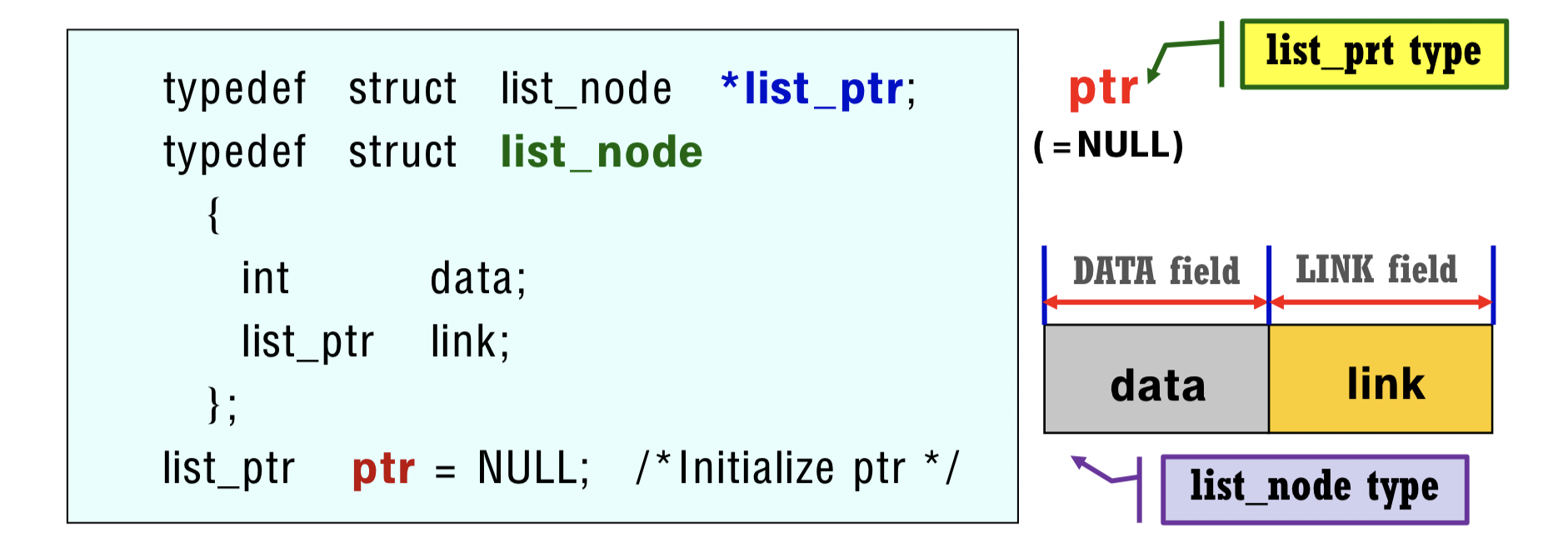
4.5 Operators
4.5.1 Basic Operations
- All the variables
p, q, r, ... are list_ptr type
- Initialize Pointer Value:
p = NULL
- Move to the next node:
p = p -> LINK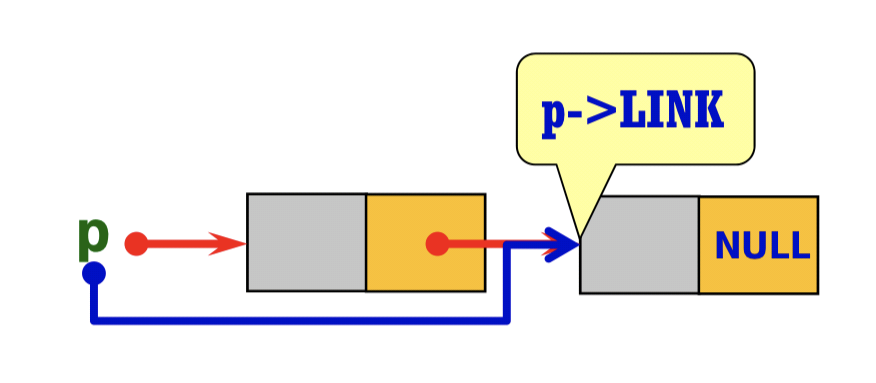
- Assign Pointer value : Sharing the same node
q = p, q = r, ...
- Compare Pointer Values : only permit
==, !=
if (p == q) then ...if (p != q) then ...if (p == NULL) then ...if (p -> LINK == NULL) then ...
4.5.2 Insert
- To do this, three variables* are required.
ptr : pointing to the first node in a listins : pointing to the insert positionnew : pointing to the new node
- Two cases are considered
- case 1 : list is empty (i.e.,
ptr is NULL)
- case 2 : list is not empty (i.e.,
ptr)
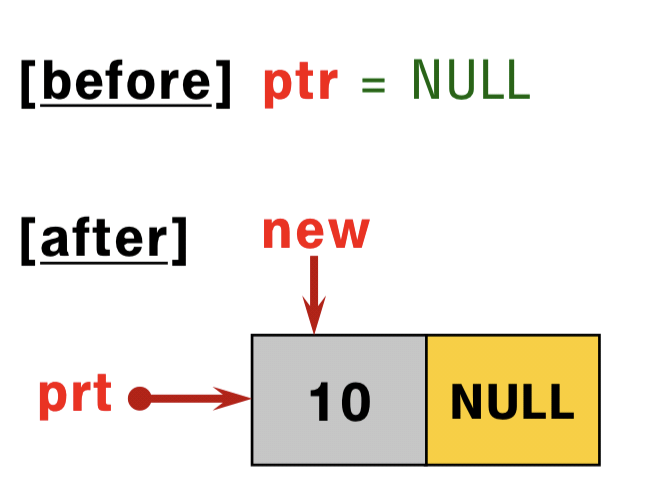

void Insert (list_ptr *ptr, list_ptr ins) {
list_ptr new;
new = (list_ptr) malloc(sizeof(list_node));
new -> data = 25;
if (*ptr != NULL) { /*In case, list is not empty*/
new -> link = ins -> link;
ins -> link = new;
}
else { /*In case, list becomes empty*/
new -> link = NULL;
*ptr = new;
}
}
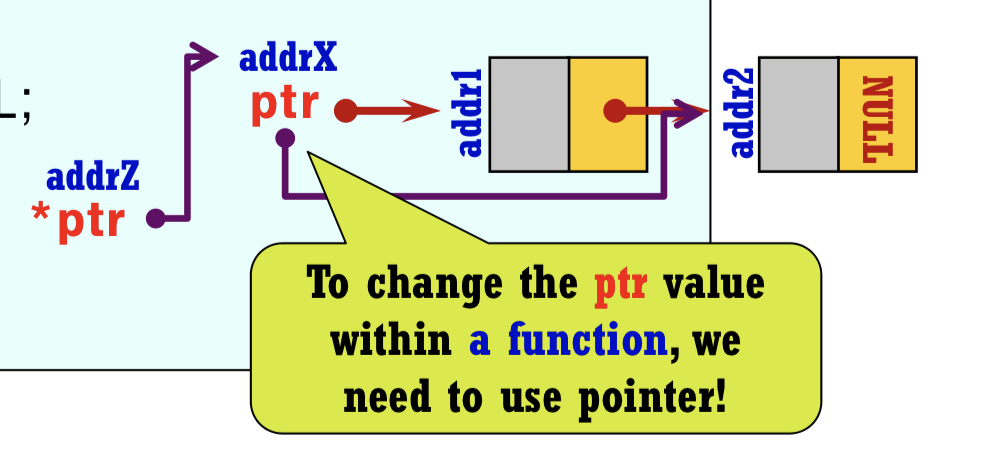
4.5.3 Delete
- To this end, three variables are also required.
ptr : pointing to the first node in a listdel : pointing to the delete positionpre : pointing to the preceding node w.r.t the delte node
- Two cases exist w.r.t the delete position
- case 1 : the fisrt node in a list (i.e., prev is
NULL)
- case 2 : other nodes except the first node (i.e., ptr in
not NULL)
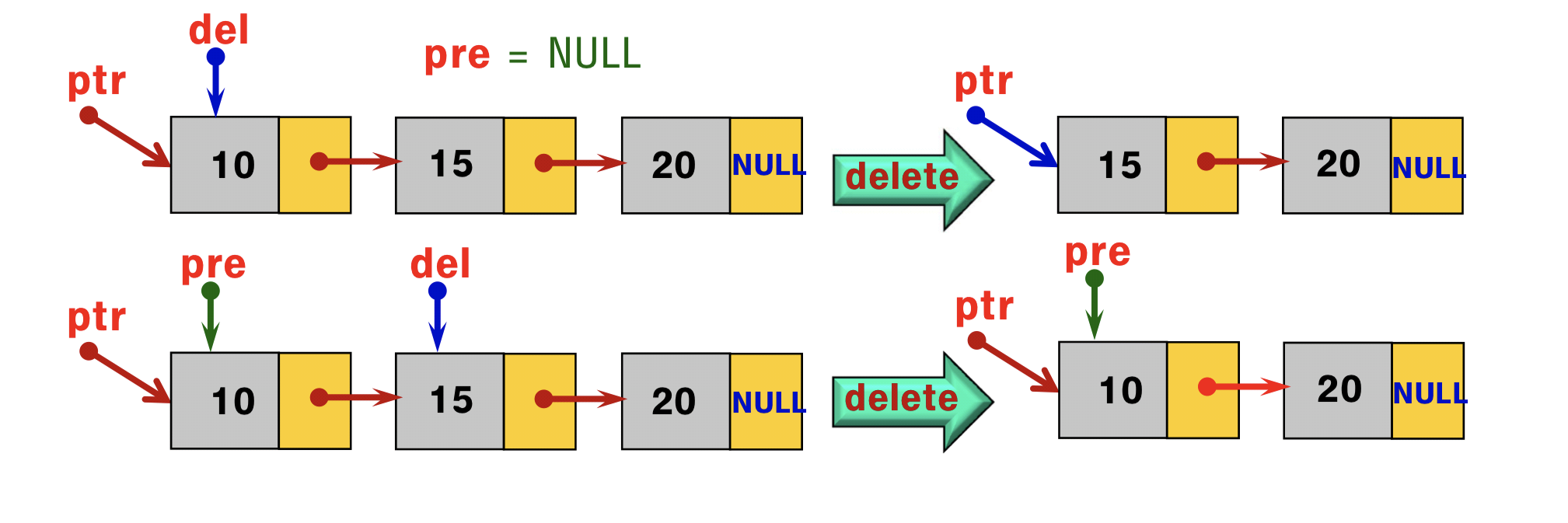
void Delete(list_ptr *ptr, list_ptr pre, list_ptr del){
if (pre != NULL){
///In case, the delete node is not the first node
pre -> link = del -> link;
}
else{ ///In case, the delete node is the fisrt node
*ptr = (*ptr) -> link;
free(del); ///Deallocate the delete node
}
}
4.5.4 Traverse
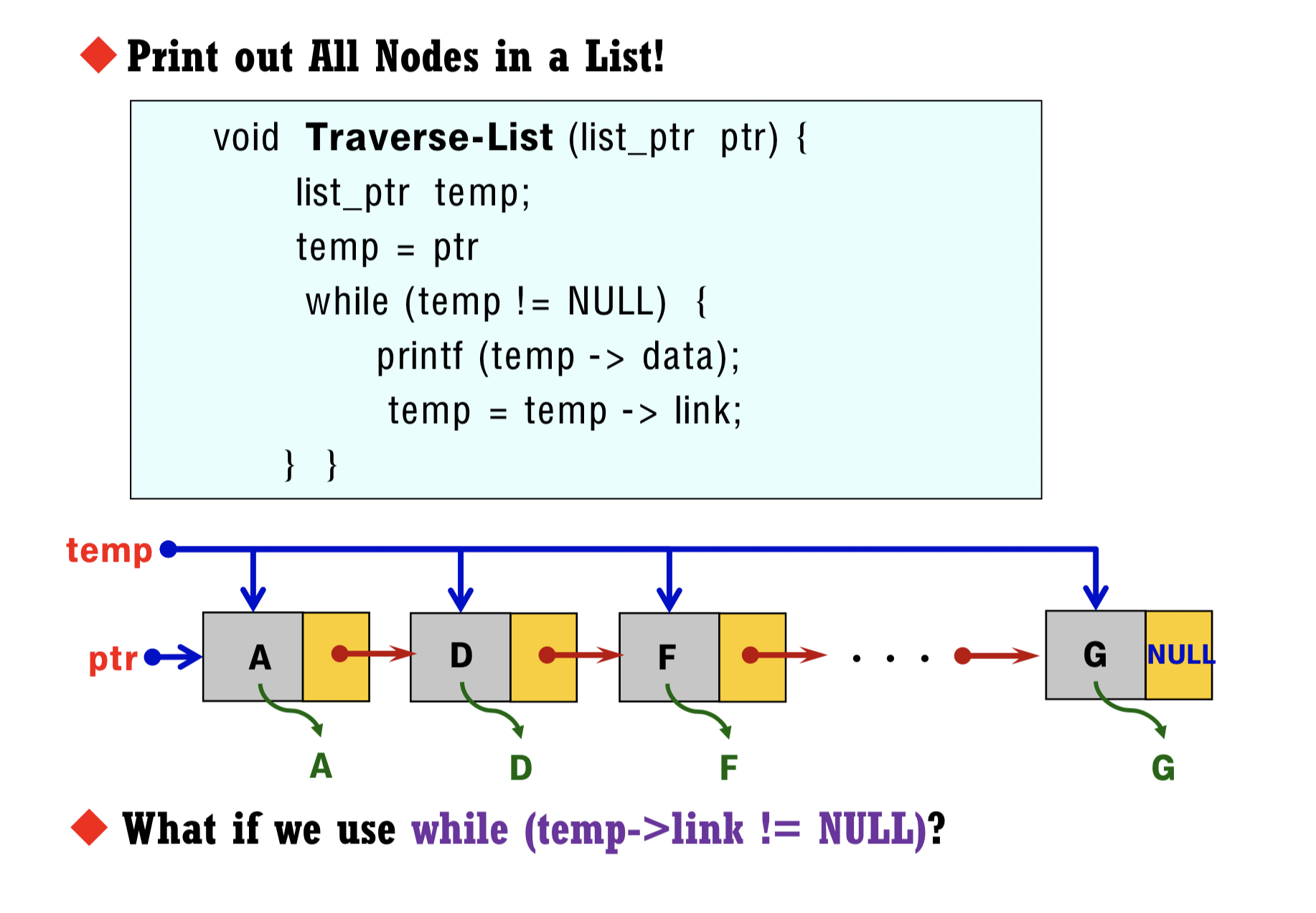
자료 구조
4. Linked List
4.1 정의

- A Linked List consist of many nodes
- A LINK contains address of (= points to) the next node.
- Address of nodes is not sequential (Address of nodes may change on run time)
- Array와 가장 다른 점
- Size of a linked list is not predefined.
- There is a pointer pointing to the first node of a linked list.
- There is a special address value(=NULL) at the last node
4.2 Array와 Linked List의 차이점
4.2.1 Array
- Sequential representation
- Insert & Delete : Inefficient due to data shift - O(n)
- Size of data must be predefined
- Static storage allocation (during compile time)
4.2.2 Linked List
- **Non-sequential representation
- Insert & Delete : Efficient due to avoiding data shift - O(1)
- Size of data needs not to be predefined
- Dynamic storage allocation (during run time)
4.3 Allocation/Deallocation
- (Memory) Allocation
- Get a currently available node.
- malloc Function

- (Memory) Deallocation
- Return a no longer unused node
- free function

4.4 Mechanisms
4.4.1 Simple Insertion
- To insert ‘eat’ between ‘cat’ and ‘fat’

- Newly allocate a node by a pointer variable
p, and stroe ‘eat’ at the node’sDATA. - Assign the
LINKofpto the node after “cat”, which contains “fat”. - Assign the
LINKof the node “cat” top. 
4.4.2 Simple Deletion
- To delete ‘fat’ from the list

- Assign the
LINKof ‘fat’ node to theLINKof ‘cat’ node - Return (deallocate) the ‘fat’ node by using
free 
4.4.3 Node Definition
- Define the node, named ‘
list_node’, by using struct - Each
list_nodeconsist of two fields,DATAandLINK - list_ptr is a pointer type pointing to the next
list_node - prt is a pointer variable defined on *list_ptr, initially
NULL 
4.5 Operators
4.5.1 Basic Operations
- All the variables
p, q, r, ...are list_ptr type - Initialize Pointer Value:
p = NULL
- Move to the next node:
p = p -> LINK
- Assign Pointer value : Sharing the same node
q = p, q = r, ...
- Compare Pointer Values : only permit
==, !=if (p == q) then ...if (p != q) then ...if (p == NULL) then ...if (p -> LINK == NULL) then ...
4.5.2 Insert
- To do this, three variables* are required.
ptr: pointing to the first node in a listins: pointing to the insert positionnew: pointing to the new node
- Two cases are considered
- case 1 : list is empty (i.e.,
ptrisNULL) - case 2 : list is not empty (i.e.,
ptr) 
- case 1 : list is empty (i.e.,

void Insert (list_ptr *ptr, list_ptr ins) {
list_ptr new;
new = (list_ptr) malloc(sizeof(list_node));
new -> data = 25;
if (*ptr != NULL) { /*In case, list is not empty*/
new -> link = ins -> link;
ins -> link = new;
}
else { /*In case, list becomes empty*/
new -> link = NULL;
*ptr = new;
}
}

4.5.3 Delete
- To this end, three variables are also required.
ptr: pointing to the first node in a listdel: pointing to the delete positionpre: pointing to the preceding node w.r.t the delte node
- Two cases exist w.r.t the delete position
- case 1 : the fisrt node in a list (i.e., prev is
NULL) - case 2 : other nodes except the first node (i.e., ptr in
not NULL) 
- case 1 : the fisrt node in a list (i.e., prev is
void Delete(list_ptr *ptr, list_ptr pre, list_ptr del){
if (pre != NULL){
///In case, the delete node is not the first node
pre -> link = del -> link;
}
else{ ///In case, the delete node is the fisrt node
*ptr = (*ptr) -> link;
free(del); ///Deallocate the delete node
}
}
4.5.4 Traverse


Comments